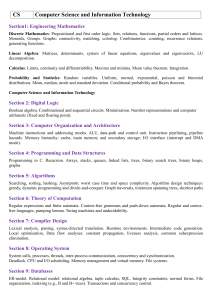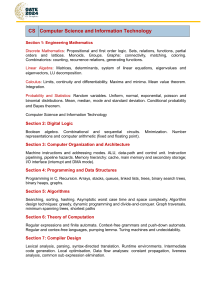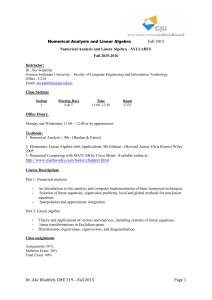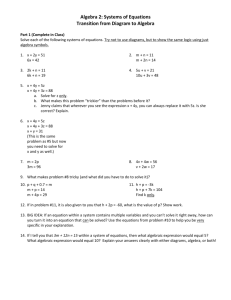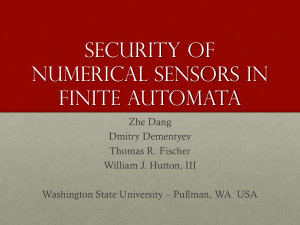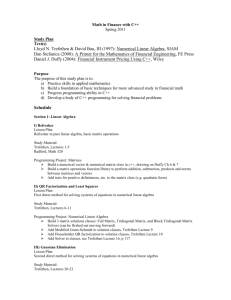Syllabus for Information Technology
advertisement
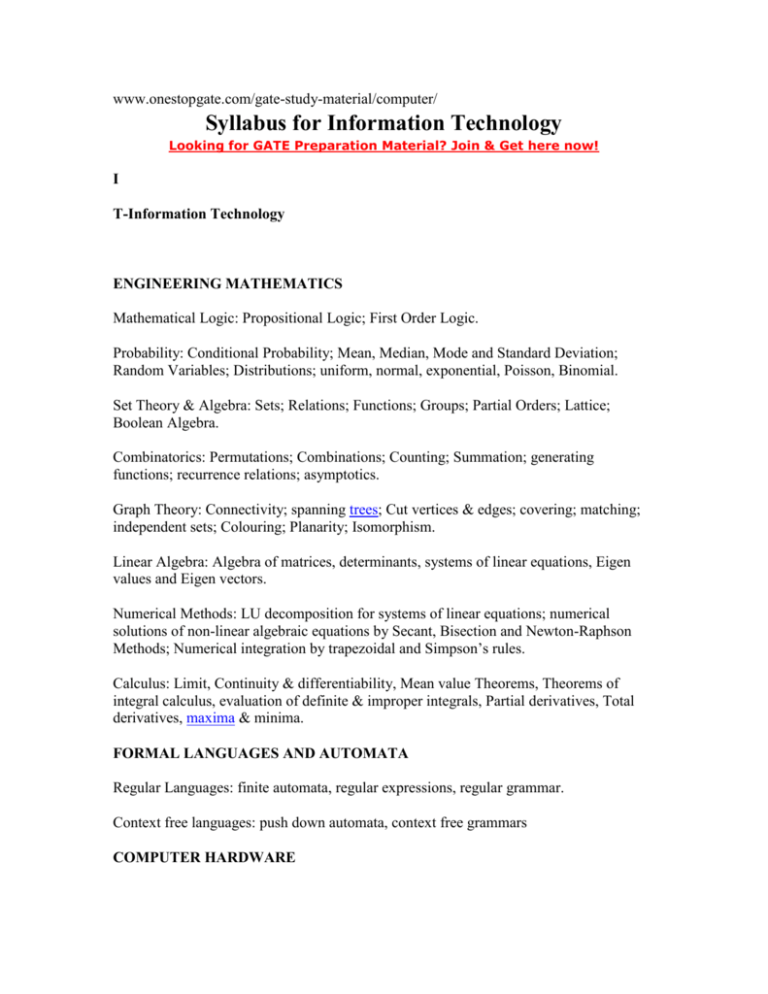
www.onestopgate.com/gate-study-material/computer/ Syllabus for Information Technology Looking for GATE Preparation Material? Join & Get here now! I T-Information Technology ENGINEERING MATHEMATICS Mathematical Logic: Propositional Logic; First Order Logic. Probability: Conditional Probability; Mean, Median, Mode and Standard Deviation; Random Variables; Distributions; uniform, normal, exponential, Poisson, Binomial. Set Theory & Algebra: Sets; Relations; Functions; Groups; Partial Orders; Lattice; Boolean Algebra. Combinatorics: Permutations; Combinations; Counting; Summation; generating functions; recurrence relations; asymptotics. Graph Theory: Connectivity; spanning trees; Cut vertices & edges; covering; matching; independent sets; Colouring; Planarity; Isomorphism. Linear Algebra: Algebra of matrices, determinants, systems of linear equations, Eigen values and Eigen vectors. Numerical Methods: LU decomposition for systems of linear equations; numerical solutions of non-linear algebraic equations by Secant, Bisection and Newton-Raphson Methods; Numerical integration by trapezoidal and Simpson’s rules. Calculus: Limit, Continuity & differentiability, Mean value Theorems, Theorems of integral calculus, evaluation of definite & improper integrals, Partial derivatives, Total derivatives, maxima & minima. FORMAL LANGUAGES AND AUTOMATA Regular Languages: finite automata, regular expressions, regular grammar. Context free languages: push down automata, context free grammars COMPUTER HARDWARE Digital Logic: Logic functions, minimization, design and synthesis of combinatorial and sequential circuits, number representation and computer arithmetic (fixed and floating point) Computer organization: Machine instructions and addressing modes, ALU and data path, hardwired and microprogrammed control, memory interface, I/O interface (interrupt and DMA mode), serial communication interface, instruction pipelining, cache, main and secondary storage SOFTWARE SYSTEMS Data structures and Algorithms: the notion of abstract data types, stack, queue, list, set, string, tree, binary search tree, heap, graph, tree and graph traversals, connected components, spanning trees, shortest paths, hashing, sorting, searching, design techniques (greedy, dynamic, divide and conquer, Algorithm design by induction), asymptotic analysis (best, worst, average cases) of time and space, upper and lower bounds, Basic concepts of complexity classes – P, NP, NP-hard, NP-complete. Programming Methodology: Scope, binding, parameter passing, recursion, C programming – data types and declarations, assignment and control flow statements, 1-d and 2-d arrays, functions, pointers, concepts of object-oriented programming - classes, objects, inheritance, polymorphism, operator overloading. Operating Systems (in the context of Unix): classical concepts (concurrency, synchronization, deadlock), processes, threads and interprocess communication, CPU scheduling, memory management, file systems, I/O systems, protection and security, shell programming. Information Systems and Software Engineering: information gathering, requirement and feasibility analysis, data flow diagrams, process specifications, input/output design, process life cycle, planning and managing the project, design, coding, testing, implementation, maintenance. Databases: E-R diagrams, relational model, database design, integrity constraints, normal forms, query languages (SQL), file structures (sequential, indexed), b-trees, transaction and concurrency control. Data Communication and Networks: ISO/OSI stack, transmission media, data encoding, multiplexing, flow and error control, LAN technologies (Ethernet, token ring), network devices – switches, gateways, routers, ICMP, application layer protocols – SMTP, POP3, HTTP, DNS, FTP, Telnet, network security – basic concepts of public key and private key cryptography, digital signature, firewalls Web technologies: Proxy, HTML, XML, basic concepts of cgi-bin programming.

